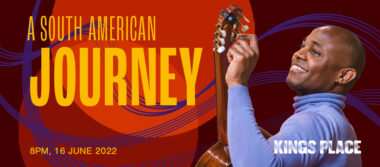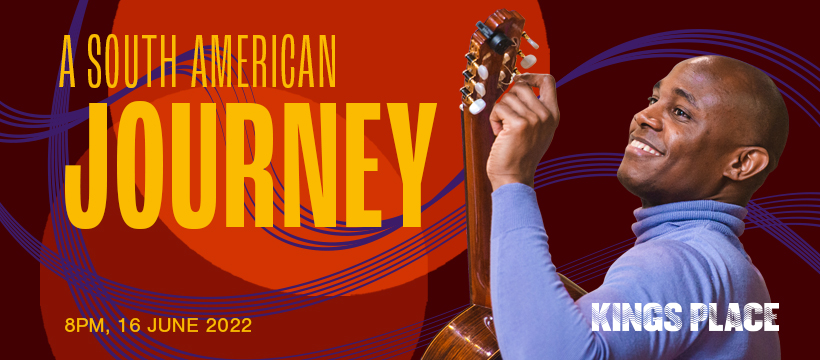 United KingdomA South American Journey: Ahmed Dickinson Cárdenas (guitar), Bath Festival Orchestra / Peter Manning (conductor). Kings Place, London, 16.6.2022. (CC)
United KingdomA South American Journey: Ahmed Dickinson Cárdenas (guitar), Bath Festival Orchestra / Peter Manning (conductor). Kings Place, London, 16.6.2022. (CC)

Teresa Carreño – Serenade for Strings
Leo Brouwer – Canciones Remotas
Villa-Lobos – Guitar Concerto, W501
Ginastera – Concerto for Strings, Op.33
Pre-concert event:
Villa-Lobos (arr. Harry Baker) – Bachianas brasileiras No.2 (excerpt)
Students from the Bobby Moore Academy
A fascinating journey across South America here, beginning with a Serenade for Strings by the Venezuelan pianist, soprano, conductor and composer María Teresa Gertrudis de Jesús Carreño García (1853-1917). As a pianist, Carreño was known as the ‘Valkyrie of the piano’; she also taught the composer Edward MacDowell. Her Serenade for Strings of 1895 is a lushly Romantic work, its lighter moments belying the fact it was composed in the middle of a divorce from Eugen d’Albert. The piece is cast in four movements. All credit to the Bath Festival Orchestra for keeping it together in some of the trickier writing; Peter Manning is clearly a fine conductor, his gestures clear and yet expressive. The Scherzo second movement perhaps felt a little held back, but the moments of a Venezuelan take on Mendelssohn’s A Midsummer Night’s Dream towards the end were delightful. The third movement begins with a cello solo, expertly played by Nina Kiva, balanced by a violin solo that closes the middle section (Maren Bosma). This is the epitome of Romantic, long-breathed expression, clearly enjoyed by the Bath players before the bracingly martial finale concluded matters: a little more attention to ensemble would have perhaps sealed the deal, but how inventive is Carreño’s writing here. A fabulous piece.
The Cuban guitarist and composer Leo Brouwer (b. Havana, 1939) is known mainly for his guitar output. His composition teachers include Persichetti and Wolpe; a way of leading into the fact he presents a very different, more modernistic, soundworld. The Schoenbergian harmonies of the first of his four Canciones Remotas, ‘La Voz Ritual para el Comienzo del Año’ perhaps reflects the ritual aspect of the title in its repetition of melodic cells, while the second movement, ‘Por el Cuerpo del Viento’ (Through the Body of the Wind) is beautifully sparse in its evocation of night (the suddenly fevered violin break comes as a surprise). The Bath orchestra was certainly strong in rhythm for ‘Cambio el Ritmo de la Noche’, vital and alert, before the concluding ‘Y Anduvo por la Tierra Solo’, a song of walking the earth alone, the atmosphere beautifully sustained here.
Introducing some brass and woodwind as well as a guitar into the mix, Villa-Lobos’s Guitar Concerto (first performed in 1956 and dedicated to Segovia) is a virtuoso display for the soloist; but also for the composer himself, who balances his forces beautifully. There is a sort of warm confidence about the writing that exudes reassurance for the listener; no Brouwer-like hard edges here in the first movement. The soloist, acclaimed Cuban guitarist Ahmed Dickinson Cárdenas, is clearly a master of his instrument; this was certainly on display in the cadenza, while the sheer beauty of his sound (particularly his harmonics) is remarkable. A similar level of beauty was heard in the Andantino, in the woodwind against strings. Most impressive, as was the way in which Manning was with his soloist all the way here. The finale included some magnificent guitar filigree. This is a major work (as so much Villa-Lobos is) and should surely be in every guitarist’s repertoire. More, the stature of Villa-Lobos’s music needs to be universally recognised. The clear devotion of the Bath orchestra and Dickinson Cárdenas to the score was wonderful to hear; all the more surprising that there was no encore from the guitarist (a short piece by Brouwer would have balanced it all out nicely in the context of this programme?).
Finally, Ginastera’s Concerto for Strings (‘Concerto per corde’) of 1966 comes from that composer’s late period, an arrangement of four movements of the Second String Quartet of 1958. It begins with a ‘Variazioni per i solisti’. Ginastera called his music of this period ‘neo-Expressionist’, and certainly some of the hardcore string chords attest to that. It is not a stretch of the imagination to point to the influence of Bartók on Ginastera’s writing, and even in the interruptive string upward glissandos to a sort of ‘post-Bartók’ gesture. All credit to the string principals here before the wondrously shadowy Scherzo fantastico second movement. Ginastera’s imagination is astonishing, the energy white-hot at times. The third movement is marked Adagio angoscioso (slow and distressed/anguished); some lovely, together and expressive playing from the Bath Festival Orchestra’s viola section here before a properly ‘furioso’ finale.
The Bath Festival Orchestra eschew traditional programme notes, instead including a freesheet with QR to a 42-minute Soundcloud cast, hosted by the enthusiastic Jess Gillam. The cast implies the Villa-Lobos was at some point to be heard first, so some rearrangement must have gone on in between cast and concert.
There was a pre-concert performance of Villa-Lobos from students from the Bobby Moore Academy, a charming arrangement of the Dansa from the Bachianas Brasileiras No.2, entitled ‘O Trenzinho do Caipira’, a fun five-minute piece performed with much concentration and zeal by the students. The Bath orchestra’s work with young people is absolutely to be encouraged; music needs to return to its rightful status as a vital strand of music education. This is the first orchestra in the Academy’s history; long may it continue. This is part of the Bath Festival Orchestra’s programme, Orchestrate, that aims to make music accessible to all.
Colin Clarke
